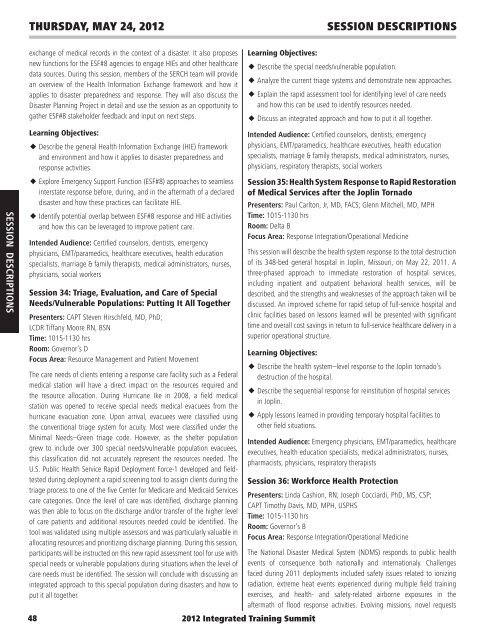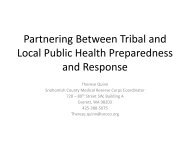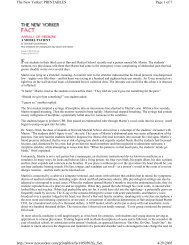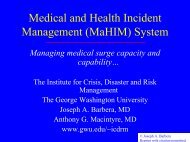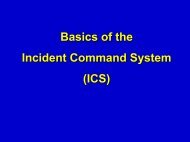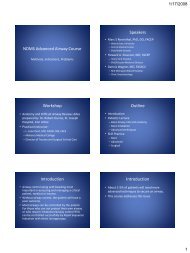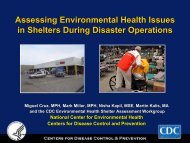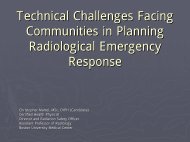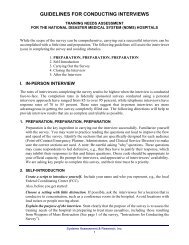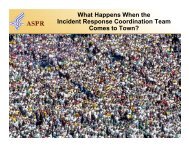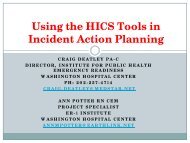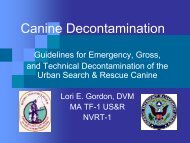THURsday, May 24, <strong>2012</strong>Session Descriptionsexchange of medical records in the context of a disaster. It also proposesnew functions for the ESF#8 agencies to engage HIEs and other healthcaredata sources. During this session, members of the SERCH team will providean overview of the Health Information Exchange framework and how itapplies to disaster preparedness and response. <strong>The</strong>y will also discuss theDisaster Planning Project in detail and use the session as an opportunity togather ESF#8 stakeholder feedback and input on next steps.Learning Objectives:u Describe the special needs/vulnerable population.u Analyze the current triage systems and demonstrate new approaches.u Explain the rapid assessment tool for identifying level of care needsand how this can be used to identify resources needed.u Discuss an integrated approach and how to put it all together.session DescriptionsLearning Objectives:u Describe the general Health Information Exchange (HIE) frameworkand environment and how it applies to disaster preparedness andresponse activities.u Explore Emergency Support Function (ESF#8) approaches to seamlessinterstate response before, during, and in the aftermath of a declareddisaster and how these practices can facilitate HIE.u Identify potential overlap between ESF#8 response and HIE activitiesand how this can be leveraged to improve patient care.Intended Audience: Certified counselors, dentists, emergencyphysicians, EMT/paramedics, healthcare executives, health educationspecialists, marriage & family therapists, medical administrators, nurses,physicians, social workersSession 34: Triage, Evaluation, and Care of SpecialNeeds/Vulnerable Populations: Putting It All TogetherPresenters: CAPT Steven Hirschfeld, MD, PhD;LCDR Tiffany Moore RN, BSNTime: 1015-1130 hrsRoom: Governor’s DFocus Area: Resource Management and Patient Movement<strong>The</strong> care needs of clients entering a response care facility such as a Federalmedical station will have a direct impact on the resources required andthe resource allocation. During Hurricane Ike in 2008, a field medicalstation was opened to receive special needs medical evacuees <strong>from</strong> thehurricane evacuation zone. Upon arrival, evacuees were classified usingthe conventional triage system for acuity. Most were classified under theMinimal Needs–Green triage code. However, as the shelter populationgrew to include over 300 special needs/vulnerable population evacuees,this classification did not accurately represent the resources needed. <strong>The</strong>U.S. Public Health Service Rapid Deployment Force-1 developed and fieldtestedduring deployment a rapid screening tool to assign clients during thetriage process to one of the five Center for Medicare and Medicaid Servicescare categories. Once the level of care was identified, discharge planningwas then able to focus on the discharge and/or transfer of the higher levelof care patients and additional resources needed could be identified. <strong>The</strong>tool was validated using multiple assessors and was particularly valuable inallocating resources and prioritizing discharge planning. During this session,participants will be instructed on this new rapid assessment tool for use withspecial needs or vulnerable populations during situations when the level ofcare needs must be identified. <strong>The</strong> session will conclude with discussing anintegrated approach to this special population during disasters and how toput it all together.48Intended Audience: Certified counselors, dentists, emergencyphysicians, EMT/paramedics, healthcare executives, health educationspecialists, marriage & family therapists, medical administrators, nurses,physicians, respiratory therapists, social workersSession 35: Health System Response to Rapid Restorationof Medical Services after the Joplin TornadoPresenters: Paul Carlton, Jr, MD, FACS; Glenn Mitchell, MD, MPHTime: 1015-1130 hrsRoom: Delta BFocus Area: Response Integration/Operational MedicineThis session will describe the health system response to the total destructionof its 348-bed general hospital in Joplin, Missouri, on May 22, 2011. Athree-phased approach to immediate restoration of hospital services,including inpatient and outpatient behavioral health services, will bedescribed, and the strengths and weaknesses of the approach taken will bediscussed. An improved scheme for rapid setup of full-service hospital andclinic facilities based on lessons learned will be presented with significanttime and overall cost savings in return to full-service healthcare delivery in asuperior operational structure.Learning Objectives:u Describe the health system–level response to the Joplin tornado’sdestruction of the hospital.u Describe the sequential response for reinstitution of hospital servicesin Joplin.u Apply lessons learned in providing temporary hospital facilities toother field situations.Intended Audience: Emergency physicians, EMT/paramedics, healthcareexecutives, health education specialists, medical administrators, nurses,pharmacists, physicians, respiratory therapistsSession 36: Workforce Health ProtectionPresenters: Linda Cashion, RN; Joseph Cocciardi, PhD, MS, CSP;CAPT Timothy Davis, MD, MPH, USPHSTime: 1015-1130 hrsRoom: Governor’s BFocus Area: Response Integration/Operational Medicine<strong>The</strong> National Disaster Medical System (NDMS) responds to public healthevents of consequence both nationally and internationaly. Challengesfaced during 2011 deployments included safety issues related to ionizingradiation, extreme heat events experienced during multiple field trainingexercises, and health- and safety-related airborne exposures in theaftermath of flood response activities. Evolving missions, novel requests<strong>2012</strong> Integrated Training Summit
THURsday, May 24, <strong>2012</strong>Session Descriptions<strong>from</strong> U.S. Government agencies, and an ever-increasing and sophisticatedtalent pool among disaster healthcare responders added unique missionspreviously unconsidered. Novel assignments deployed in under 48 hoursincluded rail-transport medical teams, public health assessment teamsdeployed to wide areas, and the development and integration of safetyand health systems for oil cleanup workers. Subsequently, the health andsafety system has grown through response, learning that their protectivemeasures were captured within the products provided by the OperationalMedicine Program: the Hazard Evaluation Risk Assessment (HERA) tool, theHealth and Safety Plan (HASP) template, and various safety and healthrelatedprograms and operating procedures. This session examines eachof these unique hazards that presented during the NDMS 2011 responseseason. It describes the protocol identified to address them and examineshow these protocols are being institutionalized, with emphasis on rapidand light response capabilities. <strong>The</strong> Office of the Assistant Secretary for<strong>Preparedness</strong> and Response (ASPR)/NDMS protocols now include responderand environmental measurements and prescreening, retrospective exposureassessments, and integration of health and safety response assets personnel<strong>from</strong> other deployed agencies. Communication of these products andprocedures is now occurring electronically.Learning Objectives:u Identify special hazards associated with response to potentialradiological hazardous situations, thermal extremes, long-termdeployments, and long-term public health hazards.u Identify the special hazards associated with rapid and light NDMSdeployment activities.u Identify NDMS force protection programs and their components inplace to protect responders <strong>from</strong> the hazards of ionizing radiation,temperature extremes, and post-disaster public health hazards, inboth traditional and rapid deployment scenarios.u Explain the worker safety and health requirements that new faster,lighter, smaller, specialty response teams will create, as well asremedies.u Utilize and retrieve information <strong>from</strong> the NDMS Force Protection,Health and Safety E-Learning Site (online), and use the site to accessprotective measures.Intended Audience: Certified counselors, dentists, emergencyphysicians, EMT/paramedics, environmental health personnel, healthcareexecutives, health education specialists, industrial hygienists, marriage &family therapists, medical administrators, morticians, nurses, physicians,respiratory therapists, social workers, veterinariansSession 37: In the Line of Fire: How to Prepare for,Respond to, and Recover <strong>from</strong> a Shooting IncidentPresenters: Craig DeAtley, MSHSc; Mark Potter;Mitch Saruwatari, PhD, EMT, MPHTime: 1300-1415 hrsRoom: Bayou CDFocus Area: Healthcare SystemsOver the past few years, media reports regarding workplace violenceoccurring in healthcare facilities have become far too common. Forexample, within the last year, there have been shootings at hospitals inBaltimore and suburban Washington, DC, and in a long-term-care facilityin North Carolina. For many facilities, the risk of an active shooter incidenthas subsequently become a priority risk in their hazard vulnerability analysis(HVA). This requires an increased need for a carefully thought-out responseplan that is fully integrated within the various levels of the healthcare facilityas well as among area law enforcement professionals. This session will focuson planning considerations for an active shooter <strong>from</strong> three perspectives:law enforcement early recognition and response recommendations, hospitalemergency management concerns for preparing a response plan, andhealthcare community response issues for supporting a facility impacted bythis type of incident.Learning Objectives:u Discuss early recognition and de-escalation activities for reducing therisk of hospital-based workplace violence.u Cite specific response considerations once an active shooter incidentbecomes imminent.u Outline the issues an emergency manager faces in writing an activeshooter response plan.Intended Audience: Certified counselors, emergency physicians,EMT/paramedics, healthcare executives, health education specialists,nurses, marriage & family therapists, medical administrators, physicians,respiratory therapists, social workersSession 38: Identifying the Factors: Evacuation of theMedically DependentPresenters: Bill Halstead, MPA, CEM; Jeffrey Schlegelmilch, MPH, MEPTime: 1300-1415 hrsRoom: Bayou EFocus Area: Healthcare SystemsUnder a contract with the Federal Emergency Management Agency, YaleNew Haven Health Systems (YNHHS) Center for Emergency <strong>Preparedness</strong>and Healthcare Solutions (CEPHS) (www.ynhhs.org/chs) conductedextensive research into the evacuation and sheltering needs of the medicallydependent population. A medically dependent individual can be definedas a person requiring a caregiver, medications, or specialized medicalequipment to sustain life or quality of life. Based on this research, numerousissues were identified as affecting the decision to evacuate or shelter-inplacethis population. It is vital that state and local emergency managementofficials and agencies involved in disaster planning be capable of identifyingthese factors and their effect on the determination to evacuate or shelterthis population in place. Based on their ability to recognize and considerthese issues, planners may then weigh and include them when developingor updating state, county or local emergency management plans.Learning Objectives:u Explain the difference between a population with special needs andthose considered to be medically dependent.session Descriptions<strong>2012</strong> Integrated Training Summit 49
- Page 1 and 2: Leading from PreparednessThrough Re
- Page 3 and 4: Table of ContentsAmericans with Dis
- Page 5 and 6: Integrated Training Summit Partner
- Page 7 and 8: Focus area DescriptionsFocus Area D
- Page 9 and 10: Late Breakers & Early RisersTuesday
- Page 11 and 12: Handy Perforated Daily Agendas - De
- Page 13 and 14: Handy Perforated Daily Agendas - De
- Page 15 and 16: Handy Perforated Daily Agendas - De
- Page 17 and 18: Handy Perforated Daily Agendas - De
- Page 19 and 20: WorkshopDescriptions2012 Integrated
- Page 21 and 22: Monday, May 21, 2012Workshop Descri
- Page 23 and 24: MoNday, May 21, 2012Workshop Descri
- Page 25 and 26: MoNday, May 21, 2012Workshop Descri
- Page 27 and 28: Tuesday, May 22, 2012Workshop Descr
- Page 29 and 30: WEDNESday, May 23, 2012dMIS Worksho
- Page 31 and 32: ThurSday, May 23, 2012dMIS Workshop
- Page 33 and 34: SessionDescriptionssession Descript
- Page 35 and 36: wednesday, May 23, 2012Session Desc
- Page 37 and 38: wednesday, May 23, 2012Session Desc
- Page 39 and 40: wednesday, May 23, 2012u Provide ex
- Page 41 and 42: wednesday, May 23, 2012Session Desc
- Page 43 and 44: wednesday, May 23, 2012Session Desc
- Page 45 and 46: Thursday, May 24, 2012Session Descr
- Page 47: THURsday, May 24, 2012Session Descr
- Page 51 and 52: THURsday, May 24, 2012Session Descr
- Page 53 and 54: THURsday, May 24, 2012Session Descr
- Page 55 and 56: THURsday, May 24, 2012Session Descr
- Page 57 and 58: FRIday, May 25, 2012Session Descrip
- Page 59 and 60: Tuesday, May 22, 2012MRC WorkshopsM
- Page 61 and 62: Tuesday, May 22, 2012MRC WorkshopsL
- Page 63 and 64: Continuing Education InformationCon
- Page 65 and 66: Continuing Education InformationSes
- Page 67 and 68: Planning CommitteeDawn AnastasiaChe
- Page 69 and 70: PresentersBrian Abrahamson, BAGaylo
- Page 71 and 72: PresentersMary Massey, BSN, MA, MEP
- Page 73 and 74: Presenter DisclosuresAlliance betwe
- Page 75 and 76: 2012 Poster PresentationsMRCPoster
- Page 77 and 78: 2012 Poster PresentationsApplicatio
- Page 79 and 80: 2012 Poster PresentationsCollaborat
- Page 81 and 82: 2012 Poster PresentationsEducation
- Page 83 and 84: 2012 Poster PresentationsSpecial Co
- Page 85 and 86: Integrated Training Summit Acronym


